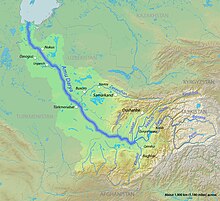Great Amu Darya shovel sturgeon
| Great Amu Darya shovel sturgeon | ||||||||||||
|---|---|---|---|---|---|---|---|---|---|---|---|---|

Large Amu Darya shovel sturgeon ( Pseudoscaphirhynchus kaufmanni ) |
||||||||||||
| Systematics | ||||||||||||
|
||||||||||||
| Scientific name | ||||||||||||
| Pseudoscaphirhynchus kaufmanni | ||||||||||||
| ( Kessler ex. Bogdanov, 1877) |
The large Amu Darya shovel sturgeon , also known as the great pseudo -shovel sturgeon , ( Pseudoscaphirhynchus kaufmanni ) is an endangered species of fish from the family of sturgeons (Acipenseridae). It is endemic to the Amu Darya in Central Asia.
features
With a length of up to 75 centimeters and a weight of two kilograms, the large Amu Darya shovel sturgeon is the largest of the three Pseudoscaphirhynchus species. Like the other shovel sturgeons, it has a spindle-shaped body with a widened front and a broad, flat spatula-shaped snout. The back is gray to almost black, the belly white. Two to four backward-curved spines sit on the rostrum and two more on the top of the head in front of the small eyes. In front of the transverse mouth are two pairs of unfringed barbels , of which the outer one is less than twice as long as the inner one. The upper and lower lips are divided in the middle, with the division being clearer on the thinner upper lip. The paired fins are rounded. The pectoral fins have a very strong and pointed first ray. The five rows of bone scales typical of sturgeon run along the body. The row along the back has 10 to 15 shields with 4 to 6 other small shields behind the 29- to 34-rayed dorsal fin . The side rows count from 28 to 40 and the belly rows from 5 to 11 shields. The rounded anal fin has 15 to 24 rays, in front of it there are 4 to 6, behind it another 1 to 4 small shields. Regularly distributed nodules sit between the bone shields. The upper lobe of the caudal fin is drawn out into a long filamentous appendage.
In addition to the common form, a dwarf form was described in the 1960s, whose adults remain smaller and whose dorsal, ventral and anal fins sit closer to the tail. With the small Amu Darya shovel sturgeon ( Pseudoscaphirhynchus hermanni ) the large Amu Darya shovel sturgeon often formed hybrids in the past .
distribution
Originally, the large Amu Darya shovel sturgeon occurred throughout the Amu Darya and its tributaries from the Pyanj to the brackish water areas of the mouth in the Aral Sea . Today two populations still exist in the middle reaches of the Amu Darya and in the Wachsch .
Way of life
The species colonizes fast flowing, turbulent, muddy water at depths of one to one and a half meters. Adults feed mainly on small fish, young animals on insect larvae. Reproduction takes place from late March to early May at water temperatures of 14 to 16 ° C. The males become sexually mature at five to seven years of age, the females at six to eight years of age. The animals likely reproduce every four to five years. The generation time is estimated at around ten years.
Threat and protection
The great Amu Darya shovel sturgeon is particularly threatened by the destruction of its habitat. The Amu Darya has been greatly changed by the construction of dams, water abstraction and pollution and no longer reaches the Aral Sea. As early as the 1960s, the average size had decreased to 37 centimeters in length and 241 grams in weight, with the dwarf form being the most common. The age structure of the populations is also strongly shifted towards younger animals. The species is listed in Appendix II of the Washington Convention and Appendix II of the Bonn Convention and classified as critically endangered in the IUCN Red List . In Moscow zoo breeding attempts are made.
swell
- Vadim J. Birstein: Threatened fishes of the world: Pseudoscaphirhynchus spp. (Acipenseridae) . In: Environmental Biology of Fishes . tape 48 , 1997, pp. 381-383 (English).
- Minister of Supply and Services Canada: CITES Identification Guide - Sturgeons and Paddlefish: Guide to the Identification of Sturgeon and Paddlefish Species Controlled under the Convention on International Trade in Endangered Species of Wild Fauna and Flora . Wildlife Enforcement and Intelligence Division, Environment Canada, 2001, ISBN 0-660-61641-6 (English, French, Spanish, full text [PDF; 10.9 MB ]).
- Pseudoscaphirhynchus mercantile in the endangered Red List species the IUCN 2010. Posted by: Mugue, N., 2010. Accessed October 26, 2012th
- Large Amu Darya Shovel Sturgeon on Fishbase.org (English)
- FAO factsheet
